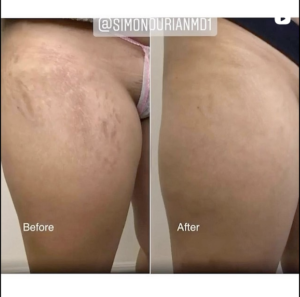Within the fabric of our skin lies a tale often overshadowed by society’s beauty standards and unattainable ideals. It is a narrative woven with streaks and lines painted in hues of pink, red, or silver. A story that touches the lives of countless individuals. Stretch marks, those imprints on our skin, hold significance more than mere cosmetic concerns. They bear witness to the dynamic nature of our bodies and the journeys we embark upon. Through this article, we set out to uncover the mysteries behind these markings that adorn our skin. While stretch marks may seem elusive, they carry a story intertwined with biology, lifestyle choices, genetic factors, and shared human experiences. Our aim is to gain insights into how they impact our lives and self-perception. We hope to equip you with knowledge and understanding that can help you navigate through your unique skin narrative.
What exactly are marks? How do they form on the skin’s surface?
Stretch marks, also known as striae, are lines that appear on the skin when it goes through stretching. This stretching causes damage to the layer called the dermis. As a result, an inflammatory response is triggered, leading to the pink appearance of fresh stretch marks. Over time, these marks mature into white lines as scar tissue replaces skin fibers. Stretch marks can occur due to factors like weight changes, pregnancy, growth spurts, and even genetics.
It is worth noting that genetics can influence an individual’s susceptibility to developing stretch marks. Some people may be genetically inclined to develop them, while others may experience them noticeably or not at all, even in similar circumstances.
What are some causes of stretch marks?
Stretch marks can occur due to factors including weight changes, pregnancy, growth spurts during puberty, bodybuilding or muscle gain, genetics, corticosteroid use in certain medical conditions, and rarely Cushing’s syndrome or Marfan syndrome.
What is the color transformation of stretch marks over time?
Fresh stretch marks are usually red, pink, or purple. This initial coloring is a result of inflammation and increased blood flow in the area caused by the stretching and damage of the skin. Some stretch marks may initially appear purple in their stage due to inflammation and dilation of blood vessels. As time passes and inflammation subsides, the damaged collagen and elastin fibers are replaced by tissue; consequently, stretch marks tend to lose their redness or purplish hue, and they become more silvery or white in color. It may also appear raised and more indented compared to the surrounding skin; these white or silvery stretch marks are considered mature or older.
Can we remove stretch marks?
While it is not possible to completely remove stretch marks, there are treatments that can help reduce their appearance. These treatments include laser therapy, microdermabrasion, chemical peels, and topical creams. It is important to note that results may vary, and complete removal is often not achievable. It is best to thoroughly discuss with your provider for proper setting of expectations.
In conclusion, although eradicating stretch marks remains a challenge, our understanding of their origins and causes has deepened. This knowledge empowers us to navigate our skin’s journey with confidence. Remember that stretch marks are a part of a shared experience; they remind us of our bodies’ changing nature. As you reflect on the complexities surrounding marks, may you embrace your skin’s story with appreciation and compassion. Beauty goes beyond perfection. Your journey etched upon your skin is a testament to your individuality and strength at Epione in Beverly Hills.
